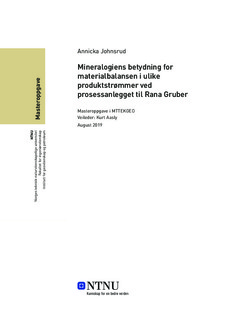| dc.contributor.advisor | Kurt Aasly | |
| dc.contributor.author | Annicka Johnsrud | |
| dc.date.accessioned | 2019-11-17T15:00:20Z | |
| dc.date.available | 2019-11-17T15:00:20Z | |
| dc.date.issued | 2019 | |
| dc.identifier.uri | http://hdl.handle.net/11250/2628831 | |
| dc.description.abstract | Dette masterprosjektet ble gjennomført i samarbeid med Rana Gruber for å skaffe innsikt i mineralbalanser i oppredningsprosessen deres for hematitt. Som del av oppgaven ble det tegnet opp et forenklet flytskjema for prosessen, både for å begrense mengden nødvendige prøvetakingspunkter og av hensyn til konfidensiell informasjon. Det ble utarbeidet en prøvetakingsstrategi i samarbeid med RG, og gjort prøvetaking ved prosessanlegget deres. Prøvene ble tatt ved til sammen 15 forskjellige punkter i prosessen, og det ble benyttet røntgendiffraksjon (XRD), røntgenfluorescens (XRF) og sveipeelektronmikroskop (SEM) for å analysere prøvene. I tillegg ble programvarene Bruker Quantax Espirit og PTA benyttet for kvantitativ mineralogi og automatisk frimalingsanalyse.
Litteraturstudium er gjort på artikkel som beskriver malmvariasjoner fra jernforekomsten det utvinnes fra. De vanligste malmtypene, males lettest ned. Enkelte resultater fra arbeidet kan tyde på at 1 av 3 dager hadde en malm med lavere grindability.
Eventuelle videre studier på variasjoner i pågang og effekt på oppredningen hos Rana Gruber bør vurdere færre prøvetakingspunkter som basis for diskusjonen og arbeidet mer rundt pågang, konsentrater og avgang.
Automatisk mineralogi ga ikke mange resultater på frimaling, og generelt var det dårlige resultater på hematittinnhold, som var feil. Videre arbeid med slip fra oppgaven kan være en ide, da kun 3 av 17 slip fra arbeidet er benyttet i denne oppgaven. Hematitt som går i avgang foreligger hovedsakelig i fine fraksjoner og er derfor konsentrert i de fineste avgangene. | |
| dc.description.abstract | This master’s thesis was completed in cooperation with Rana Gruber to acquire insight into the mineral balance in their process for dressing hematite. As part of the assignment a simplified flowsheet was created, both for simplifying the amount of sample that needed to be taken, but also because of confidentiality agreements. A sample strategy was created with Rana Gruber, and samples where then caught at their ore dressing plant. The samples were retrieved from 15 different points in the process. This samples were analysed with XRD, XRF and SEM. The software Bruker Quantax Espirit and PTA were used for quantitative minerology and automatic mineral liberation analysis.
A literature study was done on an article that describes the ore variants from the produced iron formation. The most common or types are the ones with highest grindability. Some results indicate that 1 of 3 sample days had ore that had lower grindability. But there were too few results to say anything certain. Possibility for further work on the varying feed and the effect of the variation at the ore dressing plant at Rana Gruber. There should be a bigger sample size basis for the discussion, and more work should be done around the feed, concentrates and tailings.
Automatic mineralogy did not give enough results on mineral liberation, and in general the results for hematite content was bad. Some were even wrong. Further work with polished sections from this thesis would be a good idea. Only 3 out of 17 polished sections were used in this thesis. Hematite that goes to the tailings consists mostly of finer fractions and therefor they are concentrated in the finer tailings. | |
| dc.language | nob | |
| dc.publisher | NTNU | |
| dc.title | Mineralogiens betydning for materialbalansen i ulike produktstrømmer ved prosessanlegget til Rana Gruber | |
| dc.type | Master thesis | |
